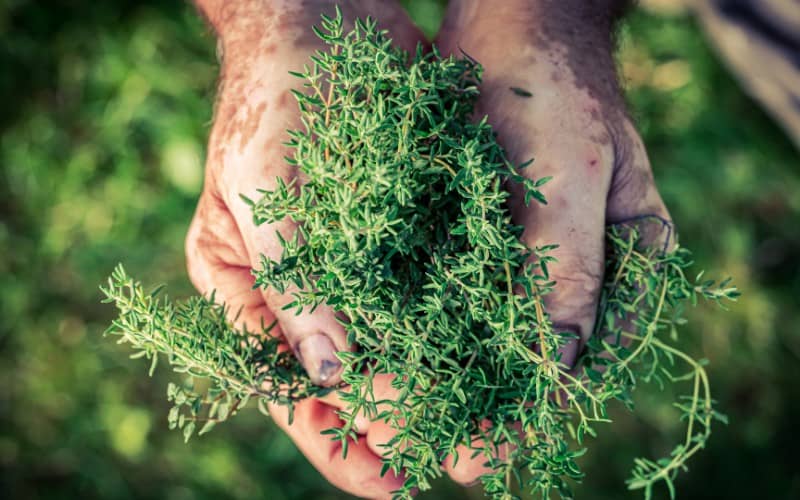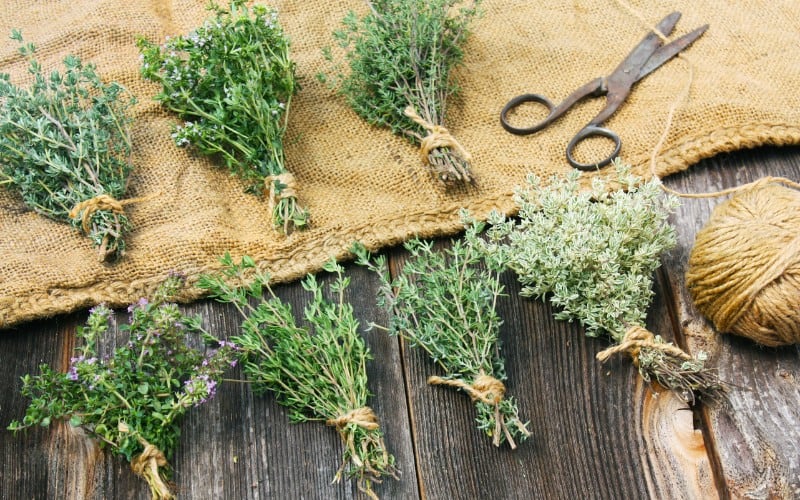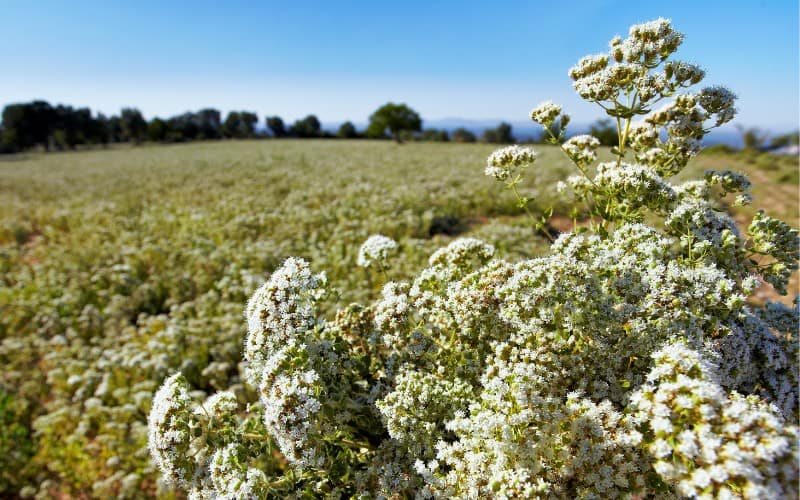Have you been harvesting thyme wrongly and killing them? Or perhaps, you are looking for how to harvest thyme without killing the plant, do not worry because we have given all the details that will enable you to harvest the plant and keep reaping from it year after year.
Thyme (Thymus vulgaris) is a perennial plant that performs especially well in somewhat dry, sunny conditions. It has more of its application in the seasoning of different dishes. It is also used as herbs for a range of ailments including whooping cough, sore throat, colic, arthritis, etc.
If well harvested, you can continue to enjoy great harvest yearly for as long as it can since thyme plant can live almost a lifetime.
Table of Contents
Does Thyme Grow Back After Cutting?
Just like all perennial, thyme will grow better when cut before flowering.
Whether you are harvesting the leaves or not, it is recommended to cut the tip of all branches to prevent blooming.
This will enable the plant to utilize the energy in producing more leaves for harvest rather than blooming.
So if you are not harvesting, you should be pruning.
The more you cut the plant, the more it grows to give you more leaves for harvest.
When is The Right Time to Harvest Thyme?

Knowing the right time to pick thyme allows the plant to live healthily without dying.
The best time to pick thyme is in early summer, when the plant is at its most productive state, just before flowering.
Of course, you can still harvest it after it has flowered, but you will lose some of its flavor and potency. Thyme can still be used after it flowers, just expect a milder flavor.
Height is also a major factor in harvesting right. While you can harvest this plant all round during summer or growing season, it is best harvested when its height reaches 8 to 10 inches.
Around this height, it should be getting ready to flower. So if there is no need for harvesting it, you should consider cutting at least 3 inches off from every tip of the branches.
The good thing about knowledge of this timing is that this is when its flavor is strongest. Lastly, we’d recommend harvesting in the morning. This is when the oil concentration is high to give you value for your harvest.
- Read Also: How to Harvest Parsley Without Killing it
How to Harvest Thyme Without Killing The Plant
Harvesting thyme without killing the plant is that easy. This is because unlike most perennial plants, thyme is rugged and most times, they can still be active when covered with frost or snow.
So how can you harvest thyme?
It only requires a pair of kitchen scissors or pruners.
Understand that thyme grows in clusters, so it may be difficult and take a long time if you have to cut each stem or branch.
So if your thyme is healthy, you should have a full bush with a cluster of stems.
Use one of your palms to hold as much of the plants that you can hold and with the aid of a pruning lopper, cut the plant at the base. You do not want to cut too low.
Most often, especially for aged plants, the base of thyme is usually wooden – so you’d want to cut to the base while leaving at least 2 inches of foliage stem above the wooden part of the stems.
How to Prepare Thyme for Winter
Apart from a wrong harvest process, lack of preparation for winter can also make the crop lose its potency to thrive over the winter and grow back the next season.
Thyme is a semi-evergreen. This means that it will retain some of its foliage during winter. For the plant to stand the chance to survive harsh winter conditions, the secret is in a good drainage and winter mulch.
However, if you are cultivating this plant indoors, you may not need this preparation since it is already protected from winter.
Immediately after your last harvest and just before the winter sets in, mulch the soil and what is left of the thyme plants. This will keep the soil as warm as possible all through the winter season.
How to Store the Harvested Thyme
The good thing about thyme is that depending on how you store or preserve it, it could last almost forever especially if properly dried.
Thyme is best used fresh when it has still got a fresh and strong flavor. Unfortunately, you do not have the opportunity to constantly harvest fresh leaves throughout the year. So you are left with no other option than to preserve it.
We will be looking at some of the best ways to preserve thyme so it can take you through till the next season where you can enjoy the fresh flavor again.
Drying
You can either dry artificially if you have got a dehydrator or dry naturally which may take a longer time. Whichever way you choose, you are going to achieve the same result.
Remove the leaves from the stalk. This is done by using your thumb and forefinger to rub through the harvested stem. It is simple, but will take time. Unfortunately, there is no simpler or quicker way.
Oh! I think there may be one. Consider drying it first before stripping off he leaves – this way it becomes easier and quicker.
If using a dehydrator, spread the leaves on the trays while leaving sufficient space for adequate circulation of heat.
The natural way to dry them is to use a thread to tie some few bunches together and hang them to dry. The best place to allow natural drying should be a cool and dry place that does not get much sunlight.
Drying naturally will take as much as 3 weeks to be ready for storage.
Store your dried thyme in an airtight container. Well-dried thyme will last as long until it gets exhausted. However, the flavor diminishes with age.
Refrigerating
Putting the leaves in a refrigerator after harvesting will allow you to enjoy a bit of the fresh leaves for a while.
You can only keep the leaves fresh for a few weeks in the refrigerator after harvesting. The idea of refrigerating is just to keep it fresh for a few days or weeks.
- Read Also: How to Harvest Kale so it Keeps Growing
Conclusion
While taking precautions in harvesting thyme, you should also prepare it for winter. The combination of these two will ensure that your plant thrives year after year.
Leave at least 2 – 3 inches of foliage stem above the ground before mulching. After the winter, as the soil starts to get warm, the thyme plant will come up stronger with better yield.






